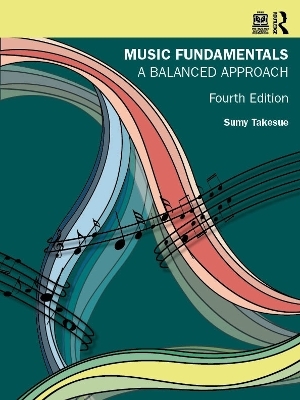
Music Fundamentals
Routledge (Verlag)
978-1-032-29040-9 (ISBN)
- Noch nicht erschienen (ca. Februar 2025)
- Versandkostenfrei innerhalb Deutschlands
- Auch auf Rechnung
- Verfügbarkeit in der Filiale vor Ort prüfen
- Artikel merken
The new edition includes:
New cultural, historical, and vocabulary references
New singing exercises with audio recordings
New and updated musical examples with audio recordings throughout
Revised counting method for compound meter (“1 la le 2 la le” in addition to “1 2 3 4 5 6”)
An enhanced e-book edition with integrated audio for musical examples and direct links to online exercises
The author’s balanced approach to beginning music theory engages student interest while demonstrating how music theory concepts apply not only to the Western classical canon but also to popular and world music. With the beginner student in mind, Music Fundamentals: A Balanced Approach, Fourth Edition is a comprehensive text for understanding the foundations of music theory.
Sumy Takesue is an Instructor at Santa Monica College, teaching theory, and class and individual piano. She has taught at the University of Hawai’i (Hilo) and the University of Southern California.
A Visual Tour of Music Fundamentals: A Balanced Approach
Preface
MODULE 1 BASICS OF PITCH
The Musical Alphabet
The Keyboard
White Keys
The Staff
Clefs
The G Clef (Treble Clef)
The Octave
Ledger Lines
Note Reading in the G Clef
Relating the Treble Clef to the Keyboard
Introduction to Singing—Why Sing?
Singing in the Treble Clef
The F Clef (Bass Clef)
Note Reading in the F Clef
Relating the Bass Clef to the Keyboard
Singing in the Bass Clef
The Grand Staff
Further Study of Ledger Lines
Octave Higher (8va) or Octave Lower (8vb)
Workbook
MODULE 2 BASICS OF RHYTHM
Pulse: Feeling the Beat
Types of Rhythmic Values
Stems and Flags
Rhythmic Patterns with Beams
Time Signature, Bar Line, Double Bar Line
Meter
Simple Meter
Comparing a Melody in Different Meters
Conducting Patterns
Workbook
MODULE 3 BASICS OF RHYTHM: EXTENDING DURATION, ANACRUSIS, RESTS
Tied Notes: Extending Duration
Slurs
Dotted Notes: Extending Duration
Fermata
Anacrusis
Rests
Workbook
MODULE 4 ACCIDENTALS
Sharp, Flat, Natural
Drawing Accidentals on the Staff
Relating Accidentals on the Staff to the Keyboard
Enharmonic Spellings
Diatonic and Chromatic Half Steps
Chromatic Scales
Whole Steps
Double Sharp, Double Flat
Workbook
MODULE 5 RHYTHM: SIMPLE METER EXPANDED
Subdividing the Quarter Note
Counting Sixteenth Note Patterns
Syncopation
Changing the Pulse Note in Simple Meter: The Half Note
Changing the Pulse Note in Simple Meter: The Eighth Note
Composing Rhythms
Workbook
MODULE 6 MAJOR SCALE
What Is a Major Scale?
Writing Major Scales: Using Tetrachords
Writing Major Scales: Using Whole and Half Steps
Scale Degree Names—Major Keys
Changing the Tonic—Singing
Transposition
Enharmonic Scales—Major Keys
Workbook
MODULE 7 MAJOR SCALE KEY SIGNATURES
Major Scale Key Signatures
Major Scales with Sharps
Finding the Tonic Note in a Major Scale with Sharps
Major Scales with Flats
Finding the Tonic Note in a Major Scale with Flats
Circle of Fifths—Major Keys
“Courtesy” Accidentals
Transposition: Using a Key Signature
Workbook
MODULE 8 RHYTHM: COMPOUND METER
Melodies in Compound Meter
First Method of Counting Compound Meter
Second Method of Counting Compound Meter
Rests
Beams
Dividing the Dotted Quarter
Comparing 6/8 and 3/4
Two-part Rhythm Exercises
Further Exercises in Compound Meter: Dotted Eighth Note Rhythms
Rhythm Review—1-, 2-, 3-part Exercises
Workbook
MODULE 9 MINOR SCALE
Minor Key Signatures
Relative Major and Minor Key Signatures
Finding the Tonic Note in a Minor Key with Sharps
Finding the Tonic Note in a Minor Key with Flats
Parallel Major and Minor Key Signatures
Circle of Fifths—Minor Keys
Three Forms of Minor Scales
Musical Examples in the Three Forms of Minor Scales
Comparing Pieces in Major and Minor Keys
Scale Degree Names in Minor
Workbook
MODULE 10 INTERVALS
Identifying Intervals
Consonance and Dissonance
Defining Quality
Intervals of the Major Scale: Perfect and Major
Interval Shortcuts
Changing Major Intervals: Minor
Changing Major and Minor Intervals: Augmented, Diminished
Changing Perfect Intervals: Augmented, Diminished
The Tritone
Simple and Compound Intervals
Descending Intervals (Interval Inversion)
Workbook
MODULE 11 TRIADS
Defining and Drawing Triads
Qualities of Diatonic Triads
Major Triad
Constructing Major Triads
Harmonizing Music Using Major Triads
Minor Triad
Constructing Minor Triads
Diminished Triad
Constructing Diminished Triads
Augmented Triad
Constructing Augmented Triads
Augmented and Diminished Triads Using Double Sharps and Double Flats
Workbook
MODULE 12 RHYTHM: COMPOUND METER EXPANDED
Changing the Pulse Note in Compound Meter: The Dotted Half Note and Dotted Eighth
Note
The Triplet
The Duplet
Workbook
MODULE 13 TRIADS: ROMAN NUMERALS
Triads of the Major Scale: Use of Roman Numerals
Primary and Secondary Triads of the Major Scale
Harmonizing Music in a Major Key Using Roman Numerals
Triads of the Harmonic Minor Scale: Use of Roman Numerals
Primary and Secondary Triads of the Harmonic Minor Scale
Harmonizing Music in a Minor Key Using Roman Numerals
Workbook
MODULE 14 INVERSIONS OF TRIADS
Defining Inversions: Root Position, First Inversion, and Second Inversion
Harmonizing Music Using Inversions
Triads in Open and Close Position
Figured Bass Symbols
Constructing and Identifying Triads Using Figured Bass Symbols
Harmonizing Music Using Roman Numerals and Figured Bass Symbols
Drawing Chord Progressions in Close Position
Workbook
MODULE 15 SEVENTH CHORDS
Qualities of Seventh Chords
Dominant Seventh Chords
Two Methods of Writing Dominant Seventh Chords
Harmonizing Music in Major Keys Using Triads or Dominant Seventh Chords in Root
Position
Inversions of Dominant Seventh Chords
Figured Bass Symbols for Seventh Chords
Harmonizing Music in Major Keys Using Inverted Dominant Seventh Chords
Chord Progressions Using Dominant Seventh Chords in Major Keys
Dominant Seventh Chords in Minor Keys
Workbook
MODULE 16 FORM IN MUSIC
Phrase Structure: Antecedent, Consequent
Cadences: Authentic, Half, Plagal, Deceptive
Authentic Cadence
Half Cadence
Plagal Cadence
Deceptive Cadence
Forms
Binary Form: Two-part Form
Ternary Form: Three-part Form
32-Bar Form (AABA)
12-Bar Blues
Repeat Signs
First Ending, Second Ending
Da Capo al Fine
Dal Segno al Fine
Coda
Workbook
APPENDICES
APPENDIX 1 Musical Terms
APPENDIX 2 Acoustics
APPENDIX 3 C Clefs (Alto and Tenor)
APPENDIX 4 Modes
APPENDIX 5 Other Seventh Chords (Major, Minor, Half Diminished, Diminished)
APPENDIX 6 Basic Guitar Chords
The following appendices can be found on the companion website:
APPENDIX 7 Keyboard Exercises (Scales, Triads, and Chord Progressions)
APPENDIX 8 Analysis of Minuet, BWV Anh. 115 (J.S. Bach)
APPENDIX 9 Analysis of Minuet, K.2 (W.A. Mozart)
APPENDIX 10 Analysis of Serious Moments, Op. 130, No. 23 (C. Gurlitt)
APPENDIX 11 Analysis of Time in a Bottle (J. Croce)
APPENDIX 12 Sansa Kroma, Akan Mmoguo Song (African playground song)
Credits
Track Listing
Index
| Erscheint lt. Verlag | 12.2.2025 |
|---|---|
| Zusatzinfo | 1493 Halftones, black and white; 1493 Illustrations, black and white |
| Verlagsort | London |
| Sprache | englisch |
| Maße | 210 x 280 mm |
| Themenwelt | Kunst / Musik / Theater ► Musik ► Musiktheorie / Musiklehre |
| ISBN-10 | 1-032-29040-4 / 1032290404 |
| ISBN-13 | 978-1-032-29040-9 / 9781032290409 |
| Zustand | Neuware |
| Haben Sie eine Frage zum Produkt? |
aus dem Bereich


